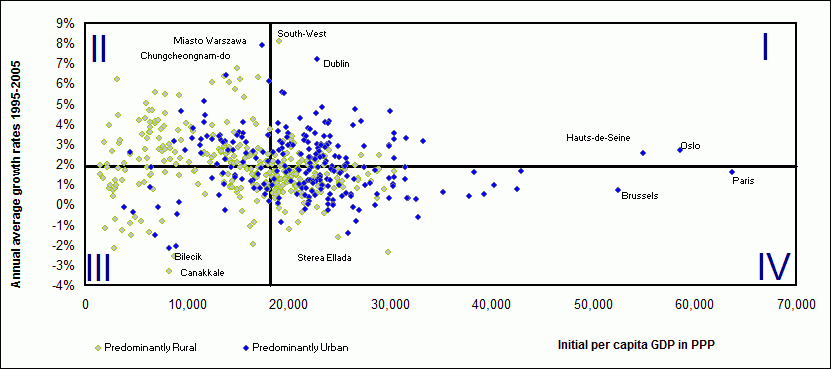In a recent Vox column “Regional Development Policies: Place-Based or People-Centred?”, Indermit Gill (2010), the World Bank’s Chief Economist for the Europe and Central Asia Region, argues strongly for the “spatially blind” approach to regional development policies advocated by the Bank’s 2009 World Development Report. Gill takes the view that the place-based approaches advocated by the EU’s Barca Report (2009) and recent OECD publications (2009, 2010a) are “kind-hearted and well intentioned” but fundamentally misguided.
Place-based vs. people-centred policies: A false debate
This debate is too important to be simplified by setting up false dichotomies. It is obvious that all good economic policies should be “people-centred”, in the sense that they should maximise welfare. In this note, we argue that in order to maximise aggregate growth and welfare, economic policies may in some instances have to take the spatial or territorial dimensions into account. This is what should be meant by "place-based policies".
The first observation is that a region’s distance from the production possibility frontier could indicate an unrealised growth potential (OECD 2009), and the evidence suggests that this is indeed the case in many lagging or under-performing regions in the OECD area. Moreover, the fact that regions of similar type (i.e. urban, intermediate and rural) display heterogeneous growth performance suggests that opportunities for growth in each of these three types undoubtedly exist.
Secondly, identifying a role for place-based policies does not imply a failure to appreciate the potential value of agglomeration economies or an expectation that economic activity will (or should) be evenly spread. A large body of economic literature points to the potential benefits of agglomeration, and some recent OECD (2010b) work has encouraged countries to revise policies that appear to be impeding concentration and integration. OECD (2009) provides evidence suggesting that regions’ growth is driven mainly by endogenous factors, including the level and quality of human capital, infrastructure, innovation, the functioning of labour markets, agglomeration forces, and the quality of institutions (see also Acemoglu and Dell 2009 on the importance of local institutions in explaining within-country differences in productivity). These are present in all regions – not only large urban centres. Moreover, the contributions to growth of large urban hubs, while significant, are not the main driver of aggregate growth. Two-thirds of aggregate growth in the OECD area is driven by the remaining regions (Garcilazo and Oliveira Martins 2010).
Thirdly, a focus on the potential role of place-based policies need not imply a neglect of the need for economy-wide (spatially-blind) improvements to institutions. We would not dispute the desirability of the “spatially blind provision of essential public services and balanced regulation of land, labour, and product markets", at least where feasible. On the contrary, such economy-wide institutions are in some respects the essential element of any place-based approach. However, one should not overlook the many fields in which the efficient provision of essential public services requires a place-based approach, whether because it raises questions of physical infrastructure or because conditions vary radically from one place to another. A spatially blind approach may actually imply excessive costs, as, for example, when policymakers confront very different challenges in providing the same services in compact urban areas and sparsely settled remote rural regions. Take for example the case of some Central and Eastern European countries that are still suffering from excessive regional concentration of some industrial or mining activities inherited from the pre-transition period. It seems obvious that a space-blind policy would just not be sufficient to cope with such a large amount of economic and spatial distortions.
An alternative
In light of these considerations, the OECD has promoted a new approach to regional policy, which aims at mobilising regions' endogenous assets and resources. This approach involves a shift in the objectives, units of intervention, strategies, tools and actors involved in place-based polices. The point is to go beyond the use of fiscal transfers to "level up" lagging regions – an approach that all agree has potential drawbacks – but rather to address the endogenous factors that may prevent a region from approaching its production possibility frontier, even when spatially blind national-level institutions and policies are sound. Instead of a zero-sum game of taxing high-wealth areas to subsidise activities in low-wealth regions, the accent is rather on the positive-sum game notably by encouraging innovative business practices.
One of the keys is to get policymakers at regional and local level to make full use of the policy instruments at their disposal to address constraints on growth; too often they themselves see regional development policy in terms of financial flows "from above". The overall objective is growth-enhancement, not compensation. To the extent that they achieve this objective, such policies may be considered people-centred, whether they are spatially blind or place-based. Thus, the dichotomy between "place-based" and "people-centred" is simply false.
Concentration and growth: What the data tell us?
Gill (2010) highlights that concentration of activity in terms of GDP per square kilometre is highly uneven. This fact cannot be disputed, but is far from sufficient to establish a simple link between concentration and growth or to demonstrate the futility of place-based policies. Evidence reported in OECD (2009) suggests a more complex picture.
Patterns of regional growth are very heterogeneous. For example, while rural regions typically have lower levels of GDP per capita than urban ones, they are about as likely to experience above-average rates of growth as below-average. Thus, a certain degree of economic convergence is taking place and actually many of the OECD’s fastest-growing regions are rural. Nevertheless, the greater dispersion of growth rates across rural regions in the Figure 1 below also highlights potential underdevelopment traps.
A closer look at the performance of urban regions suggests that the benefits of concentration are neither infinite nor linear. Only 45% of OECD metropolitan regions grew at rates faster than the national average during the decade to 2005, indicating that both agglomeration and catching-up forces were at work (see Figure 2).
Overall, across the OECD, lagging regions (those with per capita GDP at or below 75% of the national average) accounted for 44% of aggregate growth during 1995-2005, and in eight OECD countries, they accounted for over 50% of growth. Thus, policies that fail to address chronic underperformance in lagging regions overlook their actual and potential contributions to aggregate growth.
In short, while concentration of activity is associated with higher levels of productivity, employment and GDP per capita, it is clear that agglomeration is neither necessary nor sufficient for growth in OECD regions.
Figure 1. Level and growth of GDP per capita in OECD regions, 1995–2005
Notes: The Inner London-West was not included in the chart. It is located in the quadrant I and displays a GPP per capita above $90,000. Source: OECD (2009), How Regions Grow: Trends and Analysis.
Figure 2. Real GDP levels and growth in OECD metropolitan regions, 1995-2005
Source: OECD (2009)
From a theoretical perspective, this outcome is no surprise, since it reflects in part a regularity discussed in the literature since the 1960s – the so-called "Williamson Curve". Williamson (1965) extended the Kuznets hypothesis, which describes the relationship between income inequality and development, to the explanation of regional disparities. Kuznets found that income inequality tended to increase with income at low income levels and to decrease at higher levels of income. Williamson found a similar pattern at regional level in that national development created increasing regional disparities in the early stages of development, but later stages of development led to regional convergence, resulting in an inverted U-shaped curve.
The primary explanation for Williamson’s finding is that, in a catching-up country, a few regions typically drive growth, and capital and skilled workers are increasingly drawn to them. Rapidly rising productivity causes growth to accelerate still further in these regions, leading to increasing regional disparities. At later stages, higher factor costs and/or agglomeration diseconomies emerge in the leading regions, prompting investment capital to shift to places where the potential returns to capital deepening are higher (i.e. those with lower capital per worker). Otherwise we might indeed inhabit Krugman’s (1998) "infinite Los Angeles". This reallocation of productive factors may have also been driven by knowledge spillovers and a shift from a growth model driven by capital deepening to one more dependent on human capital accumulation and other factors that contribute to the growth of total factor productivity.
In fact, the evidence for the Williamson Curve is far from compelling – even those recent analyses that identify such a pattern find that other factors have a greater influence on disparities (e.g. Szörfi 2007). The crucial point here is that Williamson’s analysis, whether one accepts it in full measure or not, alerts us to the fact that the relationship between concentration and growth varies with the level of development. Moreover, the pattern it describes corresponds very well to what World Bank (2009) shows in its estimates of production concentration in major economies over the last two centuries. The initially steep upward-sloping curves flatten out over time, in some cases turning gently downwards, offering eloquent confirmation of the idea that the benefits of concentration are neither linear nor infinite. Thus, developing economies may experience both very fast growth and rapidly increasing concentration of activity, but that does not imply that the path to faster growth is forever associated with ever higher levels of concentration or that the issues confronting the most advanced economies are the same as those facing the developing world.
One might, of course, conclude that the Williamson Curve obviates all need for regional policy and that the disparities created by the early stages of the development process will naturally begin to decline later on, without any policy action at all. However, what it implies for the most developed countries is somewhat different. It suggests that aggregate growth is likely to depend increasingly on the growth of lagging regions as they approach their production possibility frontier and consequently reduce the gap with the leaders (Table 1). Of course, the performance of a country’s growth poles remains important, and it would be foolish to jeopardise their performance, but they may no longer have the same motive power as they once did. Moreover, as the growth pole regions come to suffer increasingly from congestion and other agglomeration diseconomies – including long commuting times, higher healthcare costs and rising GHG emissions – policies aimed at addressing those problems will be needed to assure their continued dynamism. Since the problems are peculiar to those regions, they will, by definition, be "place-based".
Table 1. Contributions to national growth of leading and lagging regions
Source: OECD (2009)
In this context, it is striking to note that across the OECD, regional contributions to growth are highly skewed (Figure 3) and becoming more so (Figure 3, insets). Overall, around 2% of OECD TL2 regions (roughly equivalent to NUTS 2 level) account for roughly 22% of aggregate growth; the next quarter contribute 57%; the 53% which follow them account for close to 20% of growth and the remaining 20% or so contribute next to nothing. While the first 2% are, not surprisingly, big urban centres, the cohort of about 26% of regions that follows them includes a wide variety of urban, rural and intermediate regions. What is remarkable about this pattern is that, with a few exceptions, the shape of the curve for most OECD countries is very close to that presented below for the OECD as a whole, suggesting that something like a power law regime is at work (Garcilazo and Oliveira Martins, 2010). This type of distribution is not new to economic geography or urban economics, which have for some time now noted a power-law relationship between the size and rank of cities (the so-called Zipf’s Law).
Figure 3. Regional contributions to OECD growth
OECD TL2 regions
Legend: the different colors highlight contributions to average growth across time periods ranging from 1995 to 2007. Source: Garcilazo and Oliveira Martins (2010).
Neglecting the tail
An exclusive focus on the growth poles neglects the fact that the tail of the distribution still accounts for around two-thirds of aggregate growth. To be sure, improving the performance of any one of these regions will not make much difference to overall growth, but policies that facilitate a synchronised improvement in their performance could have a substantial impact on aggregate growth. The question is whether this synchronisation could be achieved by spatially-blind policies. This is unlikely, as regional growth has to make the most of specific assets and achieve a high degree of complementarities across different sectoral policies. For example, if a region is to benefit from a new road, school, or any other type of public investment, certain conditions in terms of complementary local infrastructure or services need to be fulfilled. By definition, the latter are better designed at regional or local level. The most important impediments to such an approach are most often related to the capacity of local governments to deliver. Thus, one important role for regional development policies is to contribute to the creation of the human and social capital needed to implement such a place-based approach.
The distribution of growth contributions displayed in Figure 3 also has a number of other implications, the most important of which is perhaps that the notion of an "average or typical region" seems to be meaningless. A policy neglecting this underlying heterogeneity and focusing on averages in a spatially-blind manner could miss its target. Analysis of the determinants of regional growth suggests that the challenges facing the growth poles clustered along the Y axis differ significantly from those in the long tail running the length of the X axis. In other words, the constraints on growth are not uniform across all regions and vary according to their levels of development. Our analysis suggests that lagging regions (those with per capita GDP at or below 75% of the national average) appear to benefit from capital deepening and infrastructure investments. So-called "quasi-lagging" regions (below the national growth average but above the 75% income threshold) also appear to benefit from improved infrastructure and notably from policies that encourage labour-force activation. Finally, as regions reach higher levels of development, innovation-related policies become most important. These findings provide a spatial and regional mapping to the "appropriate growth policies" framework developed by Aghion and Howitt (2006), which focuses on the role of the distance to the frontier in determining the type of policies most conducive to growth at the aggregate country level.
In sum, good regional policy is, in essence, nothing more and nothing less than good economic policy without recourse to some macroeconomic instruments (such as exchange rate or monetary policies). Regional policy-makers thus need to be concerned with infrastructure and public investment, to be sure, but they should also be concerned with human capital development, innovation, competition, labour- and product-market regulation, stimulating entrepreneurship, and so on. In short, all the major aspects of good structural policy. In this sense, regional policy is entirely part of a sound structural policy package. In countries severely constrained by macroeconomic conditions, as currently the case for some EU members, it could actually be one of the remaining levers to promote aggregate growth. Recent history may point to some of the potential downsides of a growth regime relying excessively on urban concentration. This often contributes over time to generating housing bubbles with subsequent adverse financial market consequences. Policymakers ignore the spatial dimension of development at their peril.
References
Acemoglu, D and M Dell (2009), “Productivity Differences between and within Countries”, American Economic Journal: Macroeconomics 2010, 2(1):169-188.
Aghion, P and P Howitt (2006), “Appropriate Growth Policy: A Unifying Framework”, Journal of the European Economic Association, 4(2-3):269-314.04-05.
Barca, F (2009), “An Agenda for a Reformed Cohesion Policy”, Independent report, EC, Brussels.
Garcilazo, E and J Oliveira Martins (2010), “The contributions of Regions to Aggregate Growth”, paper presented at the Annual ERSA Conference, Stockholm August 2010 (forthcoming OECD Working Paper).
Gill, I (2010), “Regional development policies: Place-based or people-centred?”, VoxEU.org, 9 October.
Krugman, P (1998), "What’s New about the New Economic Geography?", Oxford Review of Economic Policy, 14:2.
OECD (2009), How Regions Grow: Trends and Analysis, OECD, Paris.
OECD (2010a), Regions Matter, Paris.
OECD (2010b), OECD Territorial Reviews: Sweden, OECD, Paris.
Szörfi, Béla (2007), "Development and Regional Disparities – Testing the Williamson Curve Hypothesis in the European Union", OeNB Focus 02/2007, Austrian National Bank, Vienna.
Williamson, J G (1965), "Regional Inequality and the Process of National Development: A Description of the Patterns”, Economic and Cultural Change 13:1-84.
World Bank (2009), Reshaping Economic Geography: World Development Report, The World Bank, Washington, DC, 6 November.









